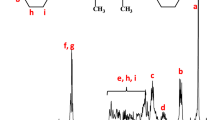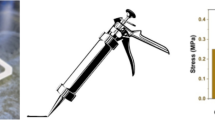Abstract
Silicone, a commonly used household and construction adhesive, filler, or sealant, is also known for its flexibility, thermal stability, and insulating properties. It is viable as a conformally 3D-printed elastomeric matrix for flexible electronics and biomedical applications. Since most of the popular 3D printing methods use precise print specifications and defined resolution, this study explored the 3D printability of commercial silicone adhesives via a paste extrusion setup. Its viscoelastic and composition properties including the dimensional accuracy and mechanical properties of printed objects using controlled print parameters have been investigated. These experimental processes in 3D printing should pave the way in using materials originally intended for household use.
Graphical Abstract





Similar content being viewed by others
Data availability
Data are available on request from the corresponding author.
References
H.-H. Moretto, M. Schulze, G. Wagner, “Silicones”, in Ullmann’s Encyclopedia of Industrial Chemistry, Weinheim (Wiley-VCH GmbH & Co. KGaA, Weinheim, 2000)
F. DeBuyl, Silicone sealants and structural adhesives. Int. J. Adhes. Adhes. 21(5), 411 (2001). https://doi.org/10.1016/S0143-7496(01)00018-5
M.G. Li, X.Y. Tian, X.B. Chen, A brief review of dispensing-based rapid prototyping techniques in tissue scaffold fabrication: role of modeling on scaffold properties prediction. Biofabrication 1, 3 (2009). https://doi.org/10.1088/1758-5082/1/3/032001
F. Liravi, R. Darleux, E. Toyserkani, Additive manufacturing of 3D structures with non-Newtonian highly viscous fluids: finite element modeling and experimental validation. Addit. Manuf. 13, 113 (2017). https://doi.org/10.1016/j.addma.2016.10.008
S.V. Murphy, A. Atala, A3D bioprinting of tissues and organs. Nat. Biotechnol. 32(8), 773 (2014). https://doi.org/10.1038/nbt.2958
F. Liravi, R. Darleux, E. Toyserkani, Nozzle dispensing additive manufacturing of polysiloxane: dimensional control. Int. J. Rapid Manuf. 5(1), 20 (2015). https://doi.org/10.1504/ijrapidm.2015.073546
G. Vozzi, A. Previti, D. De Rossi, A. Ahluwalia, Microsyringe-based deposition of two-dimensional and three-dimensional polymer scaffolds with a well-defined geometry for application to tissue engineering”. Tissue Eng. 8(6), 1089 (2002). https://doi.org/10.1089/107632702320934182
X.B. Chen, J. Kai, Modeling of positive-displacement fluid dispensing processes. IEEE Trans. Electron. Packag. Manuf. 27(3), 157 (2004). https://doi.org/10.1109/TEPM.2004.843083
V. Ozbolat, M. Dey, B. Ayan, A. Povilianskas, M.C. Demirel, I.T. Ozbolat, 3D printing of PDMS improves its mechanical and cell adhesion properties. ACS Biomater. Sci. Eng. 4(2), 682 (2018). https://doi.org/10.1021/ACSBIOMATERIALS.7B00646/SUPPL_FILE/AB7B00646_SI_002.AVI
R. Zheng, Y. Chen, H. Chi, H. Qiu, H. Xue, H. Bai, 3D printing of a polydimethylsiloxane/polytetrafluoroethylene composite elastomer and its application in a triboelectric nanogenerator. ACS Appl. Mater. Interfaces 12(51), 57441 (2020). https://doi.org/10.1021/ACSAMI.0C18201/SUPPL_FILE/AM0C18201_SI_003.MP4
T. Ching, Y. Li, R. Karyappa, A. Ohno, Y.C. Toh, M. Hashimoto, Fabrication of integrated microfluidic devices by direct ink writing (DIW) 3D printing. Sens. Actuators B 297, 126609 (2019). https://doi.org/10.1016/J.SNB.2019.05.086
E.F.D. Nordson, SmoothFlowTM Tapered Tips. https://www.nordson.com/en/divisions/efd/products/dispense-tips/tapered-tips. Accessed 13 Feb 2021.
J.R.C. Dizon, A.D. Valino, L.R. Souza, A.H. Espera, Q. Chen, R.C. Advincula, 3D printed injection molds using various 3D printing technologies. Mater. Sci. Forum 1005, 150 (2020)
J. R. C. Dizon, A. D. Valino, L. R. Souza, A. H. Espera, Q. Chen, and R. C. Advincula, “Three-dimensional-printed molds and materials for injection molding and rapid tooling applications,” MRS Commun. 9, Issue 4, 1, (2019) doi: https://doi.org/10.1557/mrc.2019.147.
W. Chen et al., Direct metal writing: controlling the rheology through microstructure”. Appl. Phys. Lett. 110(9), 094104 (2017). https://doi.org/10.1063/1.4977555
J. Zhong, G.-X. Zhou, P.-G. He, Z.-H. Yang, D.-C. Jia, 3D printing strong and conductive geo-polymer nanocomposite structures modified by graphene oxide. Carbon 117, 421 (2017). https://doi.org/10.1016/j.carbon.2017.02.102
M.C. Li et al., Cellulose nanocrystals and polyanionic cellulose as additives in bentonite water-based drilling fluids: rheological modeling and filtration mechanisms. Ind. Eng. Chem. Res. 55(1), 133 (2016). https://doi.org/10.1021/acs.iecr.5b03510
N.A. Sukindar, M.K.A. Ariffin, B.T.H.T. Baharudin, C.N.A. Jaafar, M.I.S. Ismail, Analyzing the effect of nozzle diameter in fused deposition modeling for extruding polylactic acid using open source 3D printing. J. Teknol. 78(10), 7 (2016). https://doi.org/10.11113/jt.v78.6265
H.S. Ramanath, C.K. Chua, K.F. Leong, K.D. Shah, Melt flow behaviour of poly-ε-caprolactone in fused deposition modelling. J. Mater. Sci. 19(7), 2541 (2008). https://doi.org/10.1007/s10856-007-3203-6
J.R.C. Dizon, A.H. Espera, Q. Chen, R.C. Advincula, Mechanical characterization of 3D-printed polymers. Addit. Manuf. 20, 44 (2018). https://doi.org/10.1016/j.addma.2017.12.002
A.H. Espera, A.D. Valino, J.O. Palaganas, L. Souza, Q. Chen, R.C. Advincula, A 3D printing of a robust polyamide-12-carbon black composite via selective laser sintering: thermal and electrical conductivity. Macromol. Mater. Eng. 34(4), 1800718 (2019). https://doi.org/10.1002/mame.201800718
A.C. de Leon et al., Plastic metal-free electric motor by 3d printing of graphene-polyamide powder. ACS Appl. Energy Mater. 1(4), 1726 (2018). https://doi.org/10.1021/acsaem.8b00240
Y. Tlegenov, G.S. Hong, W.F. Lu, Nozzle condition monitoring in 3D printing. Robot. Comput. Integr. Manuf. 54, 45 (2018). https://doi.org/10.1016/j.rcim.2018.05.010
S. Zhu, M.A. Stieger, A.J. van der Goot, M.A.I. Schutyser, Extrusion-based 3D printing of food pastes: correlating rheological properties with printing behaviour. Innov. Food Sci. Emerg. Technol. 58, 102214 (2019). https://doi.org/10.1016/j.ifset.2019.102214
I.J. Solomon, P. Sevvel, J. Gunasekaran, A review on the various processing parameters in FDM. Mater. Today Proc. 37, 509 (2021). https://doi.org/10.1016/j.matpr.2020.05.484
J. Triyono, A. Nurzengky, H. Sukanto, Y. Nugroho, Z. Jin, The effect of extruder pressure of 3D bioprinter on hardness and compressive of scaffold bovine hydroxyapatite. Cogent Eng. 6(1), 1586812 (2019). https://doi.org/10.1080/23311916.2019.1586812
Q. Chen, J. Zhao, J. Ren, L. Rong, P. Cao, R.C. Advincula, 3D printed multifunctional, hyperelastic silicone rubber foam. Adv. Funct. Mater. 29(23), 1900469 (2019). https://doi.org/10.1002/adfm.201900469
A.S. Wu et al., 3D printed silicones with shape memory. Sci. Rep. 7(1), 4664 (2017). https://doi.org/10.1038/s41598-017-04663-z
N.J. Holzman, 3D Printing and Mechanical Performance of Silicone Elastomers. Retrieved from the University of Minnesota Digital Conservancy. https://hdl.handle.net/11299/211309 (2019).
A.H. Espera, J.R.C. Dizon, Q. Chen, R.C. Advincula, 3D-printing and advanced manufacturing for electronics. Prog. Addit. Manuf. 4, 245 (2019). https://doi.org/10.1007/s40964-019-00077,2019
V. Dikshit, G.D. Goh, A.P. Nagalingam, G.L. Goh, W.Y. Yeong, Recent progress in 3D printing of fiber-reinforced composite and nanocomposites. Fiber Reinforc. Nanocompos. 371, 2020 (2020)
E. Luis, H.M. Pan, S.L. Sing, A.K. Bastola, G.D. Goh, G.L. Goh, Silicone 3D printing: process optimization, product biocompatibility, and reliability of silicone meniscus implants. 3D Print. Addit. Manuf. 6(6), 319 (2019)
A. Menon, B. Póczos, A.W. Feinberg, N.R. Washburn, Optimization of silicone 3D printing with hierarchical machine learning. Print. Addit. Manuf. 6(4), 181 (2019)
L.Y. Zhou, Q. Gao, J.Z. Fu, Q.Y. Chen, J.P. Zhu, Y. Sun, Y. He, Multimaterial 3D printing of highly stretchable silicone elastomers. ACS Appl. Mater. Interfaces 11(26), 23573 (2019)
E. Caldona, J.R.C. Dizon, A.H. Espera, R.C. Advincula, On the economic, environmental, and sustainability aspects of 3D printing toward a cyclic economy, in Energy Transition: Climate Action and Circularity. ed. by P.J. Boul (ACS, Washington, DC, 2022), p.507
Acknowledgments
The authors would like to thank the Case Western Reserve University and the Department of Science and Technology—Philippine Council for Industry, Energy and Emerging Technology Research and Development (DOST-PCIEERD) for the support grant that fueled our research efforts on the area of additive manufacturing. The authors also gratefully acknowledge funding from the Governor’s Chair Funds, University of Tennessee system and the Center for Materials Processing (CMP)-TCE. Technical support from Malvern Panalytical, Frontier Laboratories and Quantum Analytics is gratefully acknowledged. Part of this work was conducted by ORNL’s Center for Nanophase Materials Sciences by R.C. Advincula, which is a US Department of Energy Office of Science User Facility.
Author information
Authors and Affiliations
Corresponding author
Ethics declarations
Conflict of interest
On behalf of all authors, the corresponding author states that there is no conflict of interest.
Additional information
Publisher's Note
Springer Nature remains neutral with regard to jurisdictional claims in published maps and institutional affiliations.
Rigoberto C. Advincula was an editor of this journal during the review and decision stage. For the MRS Communications policy on review and publication of manuscripts authored by editors, please refer to http://www.mrs.org/editormanuscripts/.
Supplementary Information
Below is the link to the electronic supplementary material.
Rights and permissions
Springer Nature or its licensor (e.g. a society or other partner) holds exclusive rights to this article under a publishing agreement with the author(s) or other rightsholder(s); author self-archiving of the accepted manuscript version of this article is solely governed by the terms of such publishing agreement and applicable law.
About this article
Cite this article
Espera, A.H., Dizon, J.R.C., Valino, A.D. et al. On the 3D printability of silicone-based adhesives via viscous paste extrusion. MRS Communications 13, 102–110 (2023). https://doi.org/10.1557/s43579-022-00318-x
Received:
Accepted:
Published:
Issue Date:
DOI: https://doi.org/10.1557/s43579-022-00318-x




